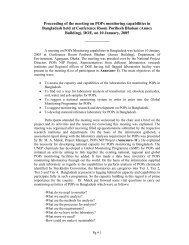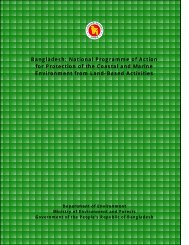Draft CMP HH - the Department of Environment
Draft CMP HH - the Department of Environment
Draft CMP HH - the Department of Environment
Create successful ePaper yourself
Turn your PDF publications into a flip-book with our unique Google optimized e-Paper software.
Coastal and Wetland Biodiversity Management Project BGD/99/G31<br />
Hakaluki Haor <strong>Draft</strong> Conservation Management Plan<br />
poecilorhyncha, A. querquedula, A. clypeata, Aythya ferina, A. nyroca and A. fuligula. O<strong>the</strong>r<br />
common species include Tachybaptus ruficollis, Phalacrocorax niger, Bubulcus ibis, Egretta<br />
garzetta, E. intermedia, E. alba, Gallicrex cincrea, Porphyrio porphyrio, Fulica atra,<br />
Hydrophasianus chirurgus, Metopidius indicus, Gelochelidon nilotica and Chlidonias hybrida.<br />
Podiceps cristatus and Phalacrocorax carbo occur in small numbers, and Leptoptilos javanicus and<br />
Anser anser have been recorded as occasional winter visitors. The Grey-headed Fish-Eagle<br />
Ichthyophaga ichthyaetus and Pallas’s Fishing eagle Haliaeetus leucorhyphus also occur at <strong>the</strong><br />
wetland.<br />
Mammals and reptiles known to occur in <strong>the</strong> area include Lutra lutra, L. perspicillata, Canis<br />
aureus, Vulpes bengalensis, Herpestes spp, <strong>the</strong> cobra Naja naja and a variety <strong>of</strong> water snakes,<br />
freshwater turtles and tortoises. O<strong>the</strong>r important wildlife at Hakaluki Haor includes a variety <strong>of</strong><br />
frogs and toads, monkeys, <strong>the</strong> Irrawady Squirrel, and <strong>the</strong> Gangetic Dolphin which inhabits <strong>the</strong><br />
Kushiara River.<br />
Wetland vegetation in Bangladesh is represented by a total <strong>of</strong> 158 species. The Hakaluki Haor<br />
system supports at least 73 <strong>of</strong> <strong>the</strong>se species, or nearly half <strong>of</strong> <strong>the</strong> national total. The flora at<br />
Hakaluki Haor is typified by a combination <strong>of</strong> ecologically important remnant swamp forest (trees,<br />
shrubs, grasses and aquatic plants) and reedlands. Swamp forests consist <strong>of</strong> Barringtonia<br />
acutangula, Pongamia pinnata, Crataeva nurvala, Trewia nudifllora and Salix tetrasperma A<br />
fully-developed stand exhibits a closed canopy with mature trees standing ten to twelve meters tall.<br />
Associated with <strong>the</strong>se at <strong>the</strong> edges <strong>of</strong> <strong>the</strong> water bodies were thick spiny bushes <strong>of</strong> wild rose Rosa<br />
clinophylla, and scrub Lippia javanica, Ficus heterophylla and Phyllanthus disticha although this<br />
form <strong>of</strong> vegetation is now largely absent.<br />
Reed swamp is adapted to lands intermediate in height between <strong>the</strong> Haor basin and homestead lands<br />
(kanda), typically on ridges surrounding <strong>the</strong> Haor. These areas are fairly deeply flooded during <strong>the</strong><br />
rainy season and dry out during <strong>the</strong> dry season.<br />
The open water aquatic vegetation consists <strong>of</strong> submerged, free floating, rooted floating and a<br />
number <strong>of</strong> emergent plants.<br />
The ECA also supports a wide variety <strong>of</strong> agricultural and horticultural crops and fast growing<br />
introduced timber species. A significant number <strong>of</strong> medicinal plant species are also found in <strong>the</strong><br />
Haor.<br />
Some 190,000 people live in <strong>the</strong> area surrounding Hakaluki Haor. As <strong>the</strong> Haor floods annually,<br />
habitations are clustered along its slightly raised fringes. Fisheries and agriculture are <strong>the</strong> two main<br />
livelihoods for local people who live in and around <strong>the</strong> ECA. O<strong>the</strong>r livelihood practices supported<br />
by Hakaluki Haor include cattle grazing, NTFP collection, duck rearing, and sand mining. Land<br />
ownership is not equally distributed among <strong>the</strong> population <strong>of</strong> <strong>the</strong> ECA. Most <strong>of</strong> it is owned by a<br />
small number <strong>of</strong> rich farming families. Land not owned privately belongs to <strong>the</strong> government and is<br />
located in <strong>the</strong> more central areas <strong>of</strong> <strong>the</strong> ECA that are prone to flooding.<br />
More generally, <strong>the</strong> Haor serves as a transport pathway particularly while it is flooded, provides<br />
water for drinking and washing, provides micro-climate regulation, and holds significant potential<br />
for generating income as a tourist attraction.<br />
Prepared by UNOPS Consultant Mr. Sulma Warne August/ September 2005 for Project BGD/99/G31 6





